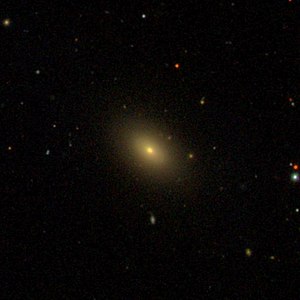NGC 4737
| Galaxy NGC 4737 |
|
|---|---|

|
|
| SDSS | |
| AladinLite | |
| Constellation | Hunting dogs |
|
Position equinox : J2000.0 , epoch : J2000.0 |
|
| Right ascension | 12 h 50 m 52.9 s |
| declination | + 34 ° 09 ′ 25 ″ |
| Appearance | |
| Morphological type | SB0 / LINER |
| Brightness (visual) | 14.3 mag |
| Brightness (B-band) | 15.1 mag |
| Angular expansion | 0.9 ′ × 0.6 ′ |
| Position angle | 50 ° |
| Surface brightness | 13.5 mag / arcmin² |
| Physical data | |
| Redshift | 0.023013 ± 0.000093 |
| Radial velocity | 6899 ± 28 km / s |
|
Stroke distance v rad / H 0 |
(310 ± 22) x 10 6 ly (94.9 ± 6.7) Mpc |
| history | |
| discovery | Wilhelm Herschel |
| Discovery date | January 12, 1786 |
| Catalog names | |
| NGC 4737 • PGC 43490 • CGCG 188-025 • MCG + 06-28-036 • 2MASX J12505290 + 3409246 • GC 3259 • H III 496 • h 1457 • GALEX ASC J125052.96 + 340924.5 • LDCE 918 NED002 | |
NGC 4737 is a 14.3 mag bright spiral galaxy with an active nucleus of the Hubble type Sab in the constellation Hounds in the northern sky . It is estimated to be 310 million light years from the Milky Way and about 80,000 light years in diameter.
The object was discovered on January 12, 1786 by Wilhelm Herschel with an 18.7-inch reflector telescope, who described it as "eF, vS, pmE".
